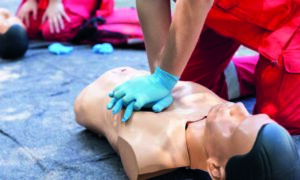Life Support Training
Emergency doesn’t discriminate, learn the skills in saving lives with our experienced & qualified training staff. Providing high-quality Cardio Pulmonary Resuscitation will make a difference between life and death. High-quality cardiopulmonary resuscitation (CPR) is the foundation of both basic and advanced life support. Solid knowledge, skills, and training in performing CPR can prolong the chances of survival and can save a life. Get trained with us and start saving lives. We offer the best rates of First Aid & Basic Life Support training & Special offer on making training contracts.

Life support training is essential for individuals who may find themselves in situations where they need to provide emergency medical care. This type of training equips participants with the knowledge and skills to respond effectively in critical situations, such as cardiac arrest, choking, or other life-threatening emergencies. Here are some key components often covered in life support training:
- Cardiopulmonary Resuscitation (CPR):
- CPR is a crucial life-saving skill that involves chest compressions and rescue breaths to maintain blood circulation and oxygenation in the absence of a pulse or breathing.
- Training includes techniques for performing CPR on adults, children, and infants.
- Automated External Defibrillator (AED) Use:
- AEDs are devices that deliver an electric shock to the heart to restore a normal rhythm during sudden cardiac arrest.
- Participants learn how to use AEDs safely and effectively, including proper placement of electrodes and following voice prompts.
- Basic Life Support (BLS):
- BLS training encompasses a broader range of life-saving skills, including CPR, AED use, and techniques for assisting a choking victim.
- Participants may also learn to recognize and respond to respiratory and cardiac emergencies.
- Choking Response:
- Training covers procedures for assisting individuals who are choking, including abdominal thrusts (Heimlich maneuver).
- Different techniques may be taught for adults, children, and infants.
- First Aid Techniques:
- Life support training often includes basic first aid skills such as wound care, bleeding control, and treatment for shock.
- Participants learn how to respond to common medical emergencies and injuries.
- Team Dynamics:
- In some courses, emphasis is placed on effective communication and coordination within a team during emergency situations.
- Training scenarios may involve collaboration with other trained individuals to simulate real-life emergencies.
- Certification:
- Participants who successfully complete life support training typically receive a certification, such as Basic Life Support (BLS) or Heart saver CPR, depending on the specific program.
It’s important to note that life support training may be offered by various organizations, including the American Heart Association (AHA), the Red Cross, and other certified training providers. The curriculum may vary slightly between different courses, but the overall goal is to prepare individuals to respond confidently and effectively in emergency situations.
Authorized By:



